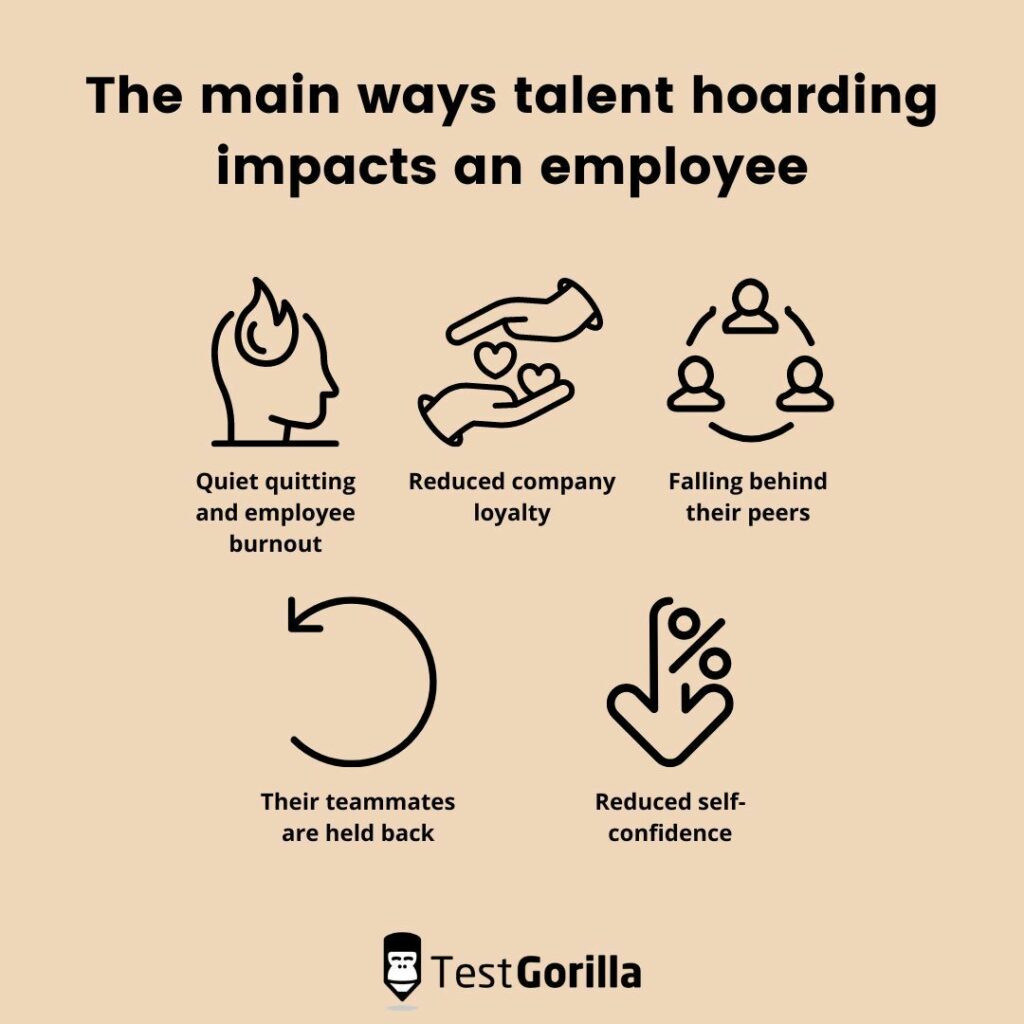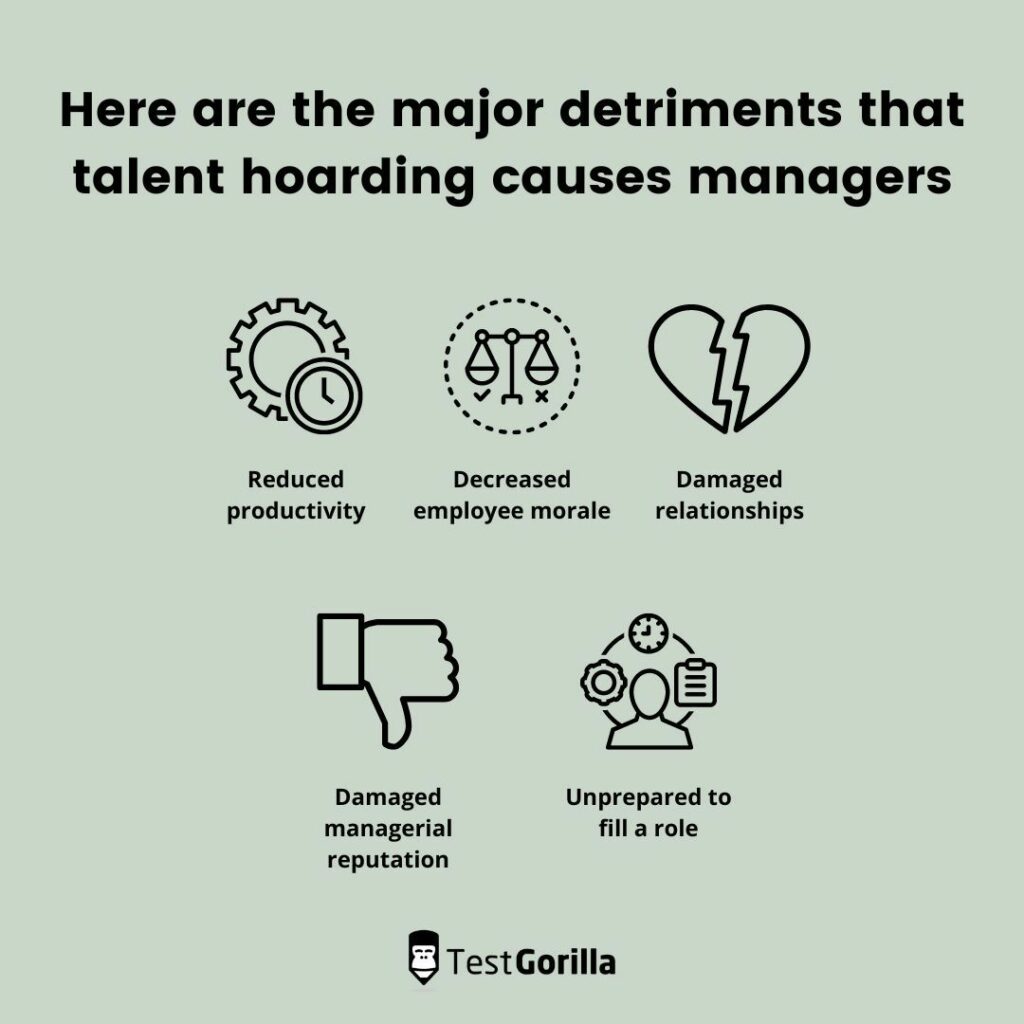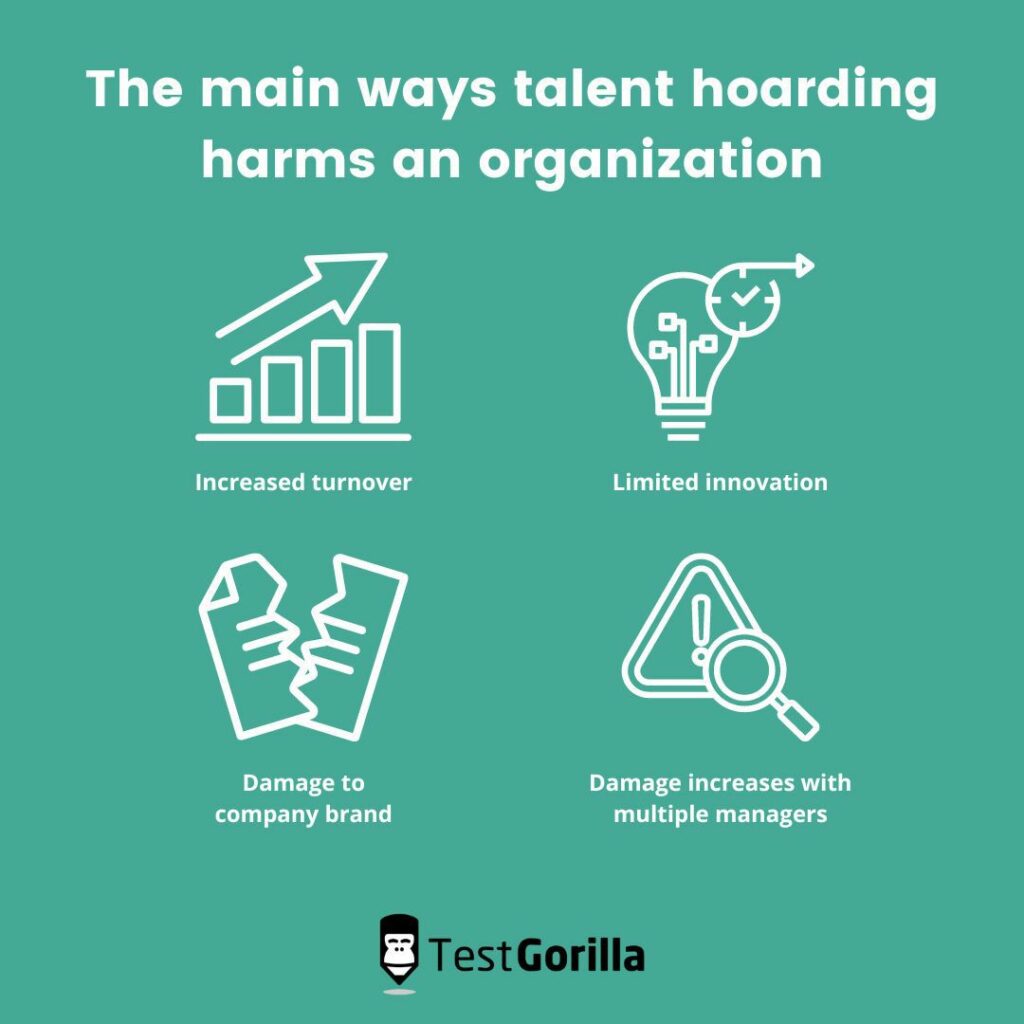Talent hoarding: The roadblock to internal mobility
The modern age, with its rampant shortages in the labor market and sky-high resignation rates, is a difficult time to retain top-talent employees.
Voluntary turnover is a huge issue. To remedy this, more organizations need to help their best employees grow their careers internally so they don’t go searching for new jobs externally.
Regardless, many managers are clipping the wings of their high-performing employees to prevent their teams from losing valuable members.
It’s called talent hoarding, and it’s slowing the process of internal mobility, which in turn is causing massive amounts of turnover and employee burnout.
In order to achieve true success with internal mobility, human resource professionals are tasked with eliminating this department-first mentality and replacing it with a company-first mindset focused on employee development.
This blog discusses talent hoarding, why it’s a detriment to your company, and how to spot it.
Then we give our top strategies for encouraging talent sharing, rather than hoarding, including adopting skills-based practices and rewarding growth-minded managers.
Table of contents
What is talent hoarding?
Talent hoarding is when a manager intentionally keeps an employee on their team despite growth opportunities. Ultimately, it’s a detriment to the employee and the company alike.
Talent hoarding in organizations limits an employee’s professional growth and denies the company exceptional talent in a new role.
This issue is more widespread than you might think – 70% of talent acquisition professionals say the main barrier to internal mobility is a manager who doesn’t want to let good talent leave their team.[1]
However, this plan doesn’t often work out since stifling an employee’s development rarely keeps them in your department. According to SHRM, inadequate career development is the leading reason people quit.
That study also showed that turnover can cost a company $1,500 per hourly worker.
Talent hoarding is making current problems with resignations and talent shortages worse than they already are. We need to facilitate the growth of our people, not halt it.
And your employees are waiting for it. Over 50% of employees say their manager could have done something to stop their departure. All it would’ve taken is a few conversations about their growth and development.
What are the dangers of talent hoarding?
Talent hoarding results in much more than a frustrated employee. The more a manager holds their talent back, the more damage it does.
It even hurts the manager themself.
Let’s discuss the main drawbacks of hoarding talent from the perspectives of the employee, the manager, and the company.
The employee’s perspective
When an employee isn’t given a clear career path, it affects their loyalty, performance, and skills.
Talent hoarding can even impact an employee’s mental health and self-confidence.
Here are the main ways talent hoarding impacts an employee:
Quiet quitting and employee burnout: When an employee is denied development, they grow detached and disengaged from their work. A lack of new skills drastically lowers the amount of accomplishment an employee feels at work.
Reduced company loyalty: Workers crave development, so if a company isn’t giving them professional growth, they lose loyalty and trust in the organization.
Falling behind their peers: Employees held back aren’t given the same treatment and opportunities as their peers. While someone with the same skills in another department is moving ahead, this worker is left behind.
Their teammates are held back: Team members can also be affected by hoarded talent because they might be waiting to fill that person’s role.
Reduced self-confidence: If an employee is continually held back despite having excellent performance, they could take a hit to self-confidence and develop imposter syndrome.
This means that even if the employee doesn’t leave, they could suffer from burnout and grow detached from the company. It can even branch out and affect other employees.
The manager’s perspective
It might seem that the manager is the only one who gets something positive out of this, but talent hoarding only amounts to you shooting yourself in the foot.
Here are the major detriments that talent hoarding causes managers:
Reduced productivity: Oddly enough, the burnout and disengagement caused by hoarding talent damages productivity, despite the fact that the manager is trying to prevent it
Decreased employee morale: Talent hoarding drains employees of morale and motivation the longer they’re denied opportunities and growth
Damaged relationships: An employee-manager relationship can suffer after stifled growth, especially if the employee has been inquiring about development and has been being actively shot down multiple times
Damaged managerial reputation: If a talented employee isn’t growing, it could reflect poorly on the manager and their abilities
Unprepared to fill a role: If the employee ends up leaving the company for new opportunities, the manager ends up unprepared and with a seat to fill
When a manager tries to protect and uphold their department over the company and employees’ well-being, it damages morale, relationships, and even the productivity they’re trying to protect.
The company’s perspective
Talent hoarding harms the company more than any other party.
Why? Because if multiple managers are doing this to multiple employees, it damages the company continually over years from multiple channels.
Let’s look at the main ways talent hoarding harms an organization:
Increased turnover: Employees are going to walk away if they don’t get well-deserved development. In fact, “frustrations with career progress” is the top reason employees give their employer after leaving.
Limited innovation: When growth is stifled and employees stagnate in their current positions, organizations don’t receive the innovation and creativity they need to evolve
Damage to company brand: A company known for suppressing employee growth isn’t a company that candidates look for, and the longer it goes on, the more damage it causes
Damage increases with multiple managers: Risks and damage increase when it isn’t just one manager, but many. This is common because talent hoarding is often a problem with company practices instead of an individual’s selfishness.
Turnover and retention are the biggest issues for a company struggling with talent hoarding. In fact, 94% of employees would stay at a company longer if it invested in their professional development.[2]
A separate, more recent study also supports this data. The researchers found that companies that excel at internal mobility have an average retention span of 5.4 years, which is nearly twice as long as companies that struggle with internal mobility.[3]
Talent hoarding can also be a detriment to an organization’s diversity, equity, and inclusion initiatives. Ingrid Haegale found that talent hoarding is highly connected to gender and affects women much more than men.
She found that if organizations prioritized talent sharing and encouraged more internal growth, it could reduce the gender employment gap by 91% and the pay gap by 77% within one year.
Why do managers hoard talent, then?
Given all the disadvantages we just discussed, why do managers still engage in talent hoarding? What’s driving this damaging behavior?
Managers are heavily incentivized to keep people where they are and few see a clear benefit to helping employees develop.
These managers fear a sharp loss in performance when a high-performing team member leaves. Further, some of them could take a financial hit if their bonus is tied to team performance.
The only incentive managers have in most organizations is the pride of helping a teammate grow – that teammate’s growth usually means much more work for the manager, something that most would understandably want to avoid.
Managers have a lot on their plate after moving an employee to a new role:
Recruiting
Re-training
Delegating tasks
It’s possible that some managers have unsavory motivations, but the problem isn’t always selfish hoarders. Often, managers have good intentions but execute their actions improperly.
Organizations need a mindset change and a better structure that rewards managers for growth instead of punishing them.
The telltale signs of talent hoarding in organizations
So how do you identify talent hoarding in organizations to put an end to it?
There are plenty of warning bells that tell you talent hoarding is taking place. Let’s take a look at a few scenarios and what HR leaders can do to help:
Employee | Detailed description | What HR Can Do |
Angela – Sales rep | Angela’s manager tells her during every 1:1 that she isn’t quite ready for growth yet | Send out pulse surveys to discover if managers encourage growth; Encourage employee referrals for growth since colleagues often recognize top performers |
Amar- SEO specialist | Amar always receives a “just below the threshold” rating on his performance reviews | Focus on a manager’s rating pattern and recognize any abnormalities; Check if you have an abundance of “just below the promotion mark” employees |
Dave- Content writer | Dave’s manager ensures that he isn’t assigned to outside tasks so that other managers won’t notice him | Calculate the percentage of above-average performers that are assigned to outside tasks, then compare that percentage to the average |
Tanisha- Front-end developer | Tanisha is purposefully kept off internal mobility lists | Monitor the percentage of employees placed on internal mobility lists; Build your own internal mobility list with your own selection criteria |
Noah- Accountant | Noah is discouraged from taking part in employee training and denied important opportunities | Keep an eye on the percentage of employees under a certain manager that are provided with development opportunities |
Li Hua- Junior marketer | Li Hua’s manager knows she’s pursuing more opportunities, so they remove responsibilities and lower her performance rating to punish “disloyalty” | Talk to employees who have applied for internal roles and ask if any punitive measures have been taken; Measure the percentage of promotion and transfer rates for the department and compare them to others |
Ajay- System admin | Ajay isn’t aware of internal opportunities because his manager hides open roles and discourages Ajay from attending job fairs | Send open job roles directly to relevant employees and encourage them to apply; Hold career events during off-hours so employees can attend them in their own time, or make them mandatory |
Jess- Graphic designer | Jess’s manager hoards talent inadvertently due to the inability to see true skill and potential | Provide company-wide talent assessments to gauge above-average performance; Inform managers if their team ratings are lower than other similar departments |
What these managers are doing isn’t right, but most of them aren’t trying to be “the bad guy.” Talent hoarding is a nuanced discussion – it isn’t black and white.
Many of these talent-hoarding tactics are quite sneaky and seemingly deceitful, but often it’s simply managers trying to survive and keep their team numbers up in an organization that incentivizes hoarding.
What we need is a new structure and a mindset change in organizations.
Here’s what you can do.
How to stop talent hoarding and start talent sharing
Talent hoarding is damaging your company, but talent sharing can make it thrive.
Talent sharing encourages and embraces the value of professional development and job rotation. It’s essentially the polar opposite of talent hoarding.
Let’s look at the top strategies to promote professional development in your organization, including adopting skills-based practices and promoting transparent internal job openings.
Summary
Strategy | Description |
1. Become a skills-based organization | Build a skills-focused mindset to facilitate filling roles based on capability rather than position experience |
2. Provide coaching and training to managers about talent hoarding | Talk to your managers and raise awareness about talent hoarding, especially if they’re not aware they’re doing it |
3. Include internal mobility as one of your company’s values | Promote internal mobility in your culture, reducing its occurrence and improving your brand image |
4. Reward and recognize managers that develop their employees’ careers | Facilitate talent sharing so it isn’t a detriment to a manager’s workload |
5. Make internal positions more transparent with an internal talent marketplace | Prioritize internal hiring for higher positions so that your employees know that you’re considering them |
6. Create clear career paths for your staff | Help your people upskill and understand how far their career can (and will) go |
1. Become a skill-based organization
A skills-based organization prioritizes skills and capabilities over traditional requirements, such as role experience.
Focusing on skills rather than roles helps build a mentality where you hire and retrain based on skills rather than roles. That way, if a role disappears (or appears), you’re ready to look inwards to find a new position for the employee or fill the gap with existing talent.
Skills-based practices also help you figure out which employees have what skills, where else they might succeed, and what training plans to use to achieve their goals.
This helps you move employees smoothly from role to role even if it’s unconventional, like going from marketing to accounting.
Here’s a sample assessment for someone entering an accounting role:
These assessments can be done upon internal application, but you can also use them to conduct regular company skills-gap analyses.
This brings an employee’s skills out in the open so everyone knows if they’re ready for development or right where they’re needed.
For more information on this topic, read our article on how to use skill tests to address internal skills gaps.
2. Provide coaching and training to managers about talent hoarding
Provide explicit coaching and training to managers about talent hoarding and how to avoid it.
Often, managers only need training on what talent hoarding is, how it affects the company, and how it happens both consciously and unconsciously to start talent sharing instead.
Here are a few topics to bring up during coaching:
How to provide feedback
How to mentor and coach
How to look beyond one or two high-performers (this helps prevent overreliance)
How to maintain relationships
How to notice talent hoarding (its telltale signs mentioned above)
It’s also important to train managers on an “organization-first” mindset versus a “team-first” mindset.
Managers are looking out for their teams and their performance, so sometimes it’s hard to see the big picture. Place emphasis on how talent hoarding affects the company and how much better it is for both the organization and the employees to develop and grow.
For more tips on training and coaching managers, read our blog post on how to be a good manager.
3. Include internal mobility as one of your company’s values
If your company holds internal mobility as a prominent value, it discourages managers from hoarding talent. It also encourages employees to stand up for themselves and actively seek out internal opportunities.
Internal mobility is a crucial element in an organization now more than ever. Millennials rank learning and growth opportunities in a job above all other considerations, and 69% of all non-Millennials say it’s important to them.[4]
This means that if you’re loud and proud about your internal mobility. It also improves your employer branding and increases job applicants.
This value should be lived in your culture and displayed everywhere prominent, such as your website, your social pages, and in your job ads and descriptions.
Learn more about this essential value in our blog post about internal mobility.
4. Reward and recognize managers that develop their employees’ careers
The primary reason talent hoarding happens is that managers fear losing an excellent team member and the repercussions that has on them.
Losing a high-performing team member could mean a drop in performance, possible financial hits, and more tasks and stress for them.
Managers who help their people grow and succeed should be rewarded. That means we have to change the status quo: We need to facilitate talent sharing by supporting managers through this process.
Here are a few ideas to make talent sharing a better experience for your managers:
Help them overcome gaps from missing team members: Provide managers with the resources they need to deal with missing teammates. Try looking into contingent workers to temporarily fill the gap.
Incentivize them instead of discouraging them: Recognize managers who share talent with kudos and spot awards.
Encourage cross-departmental training: Enable employees to move around departments to try different roles and take on new responsibilities; this can help managers deal with workload gaps and might even end in a new teammate.
You can also help your managers by creating a new position specifically taking on growth-oriented tasks. This new role, like a “growth specialist,” can help them handle the internal recruiting, re-training, and task delegating that’s weighing down on them.
5. Make internal positions more transparent with an internal talent marketplace
An internal talent marketplace is HR software where employees can input their skills and receive recommendations on suitable roles. This software makes internal job openings far more transparent so employees know about them before external hiring efforts begin.
Make it even more accessible: Clarify what the requirements are and what skills are necessary and encourage employees to develop the required skills and go for it.
An internal talent marketplace is also a valuable tool to build an internal talent pool just in case a role is suddenly vacated. This is a key component in a proactive recruitment strategy.
This software also helps shift the negative association of “losing talent” to the narrative of “talent sharing is quick, easy, and improves performance”.
Encouraging every team in your company to use the internal talent marketplace and talent share ensures that talent is gained at the same rate it’s lost.
It also addresses a rare and unfortunate possibility. The transparency of an internal talent marketplace promotes transparency, and transparency helps stop talent hoarding from managers who intentionally hide opportunities from employees.
6. Create clear career paths for your staff
Help your staff grow and develop with clear, helpful career paths.
The best way to facilitate professional growth for your staff is by helping them create career paths, meaning each employee builds a professional development plan.
Also called a PDP, these plans lay out the skills the worker needs, the goals they want to achieve, and how they’ll get there.
After you know where they want to go, you need to provide them with an abundance of upskilling and reskilling opportunities. Try offering developmental courses and workshops.
It’s also important to explicitly speak about goals and progress in 1:1 meetings and performance catch-ups.
The more you upskill, the more cross-departmental managers can access more talent, which reduces the overall need to hoard talent.
Stop talent hoarding by focusing on skills
Talent hoarding in your company is much more detrimental than it first seems, but with the right shift in mindset, we can stop it in its tracks.
The more we focus on talent sharing instead of talent hoarding, the more we can promote this act as a positive, healthy practice that helps teams grow and lets companies thrive.
As an HR professional, you can help stop talent hoarding by encouraging skills-based practices so your company focuses on transferable skills over-reliance on specific roles or positions.
To learn more about this, read our article on transferable skills checklists and how to use them.
When you’re hiring your next manager (or evaluating them through a skills gap analysis), use our Leadership and People Management test to assess their capability to help their people grow.
Sources
“2020 Global Talent Trends”. (2020). LinkedIn Talent Solutions. Retrieved February 5, 2023. https://business.linkedin.com/content/dam/me/business/en-us/talent-solutions/resources/pdfs/linkedin-2020-global-talent-trends-report.pdf
“2019 Workplace Learning Report”. (2019). LinkedIn Learning. Retrieved February 5, 2023. https://learning.linkedin.com/content/dam/me/business/en-us/amp/learning-solutions/images/workplace-learning-report-2019/pdf/workplace-learning-report-2019.pdf
“2022 Workplace Learning Report”. (2022). LinkedIn Learning. Retrieved February 5, 2023. https://learning.linkedin.com/content/dam/me/learning/resources/pdfs/linkedIn-learning-workplace-learning-report-2022.pdf
“Workplace Learning & Development Programs”. (n.d.). Gallup. Retrieved February 5, 2023. https://www.gallup.com/learning/248381/workplace-programs.aspx
Related posts
You've scrolled this far
Why not try TestGorilla for free, and see what happens when you put skills first.
Latest posts
The best advice on pre-employment testing, in your inbox.
No spam. Unsubscribe at any time.

Hire the best. No bias. No stress.
Our screening tests identify the best candidates and make your hiring decisions faster, easier, and bias-free.
Free resources
This checklist covers key features you should look for when choosing a skills testing platform
This resource will help you develop an onboarding checklist for new hires.
How to assess your candidates' attention to detail.
Learn how to get human resources certified through HRCI or SHRM.
Learn how you can improve the level of talent at your company.
Learn how CapitalT reduced hiring bias with online skills assessments.
Learn how to make the resume process more efficient and more effective.
Improve your hiring strategy with these 7 critical recruitment metrics.
Learn how Sukhi decreased time spent reviewing resumes by 83%!
Hire more efficiently with these hacks that 99% of recruiters aren't using.
Make a business case for diversity and inclusion initiatives with this data.




















